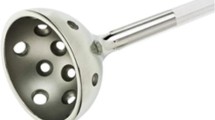Abstract
Dislocation after primary total hip arthroplasty (THA) is the most commonly encountered complication and is unpleasant for both the patient and the surgeon. Constrained acetabular components can be used to treat or prevent instability after primary total hip arthroplasty. We present the case of a 42-year-old female with a BMI of 41. At 18 months post-primary THA the patient underwent further revision hip surgery after numerous (more than 20) dislocations. She had a tripolar Trident acetabular cup (Stryker-Howmedica-Osteonics, Rutherford, New Jersey) inserted. Shortly afterwards the unusual mode of failure of the constrained acetabular liner was noted from radiographs in that the inner liner had dissociated from the outer. The reinforcing ring remained intact and in place. We believe that the patient’s weight, combined with poor abductor musculature caused excessive demand on the device leading to failure at this interface when the patient flexed forward. Constrained acetabular components are useful implants to treat instability but have been shown to have up to 42% long-term failure rates with problems such as dissociated inserts, dissociated constraining rings and dissociated femoral rings being sited. Sometimes they may be the only option left in difficult cases such as illustrated here, but still unfortunately have the capacity to fail in unusual ways.


Similar content being viewed by others
References
Soong M, Rubash HE, Macaulay W (2004) Dislocation after total hip arthroplasty. J Am Acad Orthop Surg 1:314
Woo RY, Morrey BF (1982) Dislocations after total hip arthroplasty. J Bone Jt Surg 64-A:1295
Pellicci PM, Bostrom M, Poss R (1998) Posterior approach to total hip replacement using enhanced posterior soft tissue repair. Clin Orthop 355:224
Paterno SA, Lachiewicz PF, Delley SS (1997) The influence of patient-related factors and the position of the acetabular component on the rate of dislocation after total hip replacement. J Bone Jt Surgery 79-A:1202
Alberton GM, High WA, Morrey BF (2002) Dislocation after revision total hip arthroplasty. J Bone Jt Surgery 84:1788
Su EP, Pellicci PM (2004) The Role of constrained liners in total hip arthroplasty. Clin Orthop 420:122
Thoms RJ, Marwin SE (2008) A unique failure mechanism of a constrained total hip arthroplasty: a brief review of the literature. J Arthroplasty 23(2):293–298
Berend KR, Lombardi AV Jr, Mallory TH, Adams JB, Russell JH, Groseth KL (2005) The long-term outcome of 755 consecutive constrained acetabular components in total hip arthroplasty examining the successes and failures. J Arthroplasty 20(7 Suppl 3):93–102
Kotwal RS, Ganapathi M, John A, Maheson M, Jones SA (2009) Outcome of treatment for dislocation after primary total hip replacement. J Bone Jt Surg Br 91(3):321–326
Levine BR, Della Valle CJ, Deirmengian CA, Breien KM, Weeden SH, Sporer SM, Paprosky WG (2008) The use of a tripolar articulation in revision total hip arthroplasty: a minimum of 24 months’ follow-up. J Arthroplasty 23(8):1182–1188
Kim Y, Morshed S, Joseph T, Bozic K, Ries MD (2006) Clinical impact of obesity on stability following revision total hip arthroplasty. Clin Orthop Relat Res 453:142–146
Williams JT Jr, Ragland PS, Clarke S (2007) Constrained components for the unstable hip following total hip arthroplasty: a literature review. Int Orthop 31(3):273–277
Shrader MW, Parvizi J, Lewallen DG (2003) The use of a constrained acetabular component to treat instability after total hip arthroplasty. J Bone Jt Surg 85:2179
Shapiro GS, Weiland DE, Markel DG et al (2003) The use of a constrained acetabular component for recurrent dislocation. J Arthroplasty 18:250
Conflict of interest statement
There is no conflict of interest and no financial report has been received.
Author information
Authors and Affiliations
Corresponding author
Rights and permissions
About this article
Cite this article
Banks, L.N., McElwain, J.P. An unusual mode of failure of a tripolar constrained acetabular liner: a case report. Arch Orthop Trauma Surg 130, 503–505 (2010). https://doi.org/10.1007/s00402-009-0941-6
Received:
Published:
Issue Date:
DOI: https://doi.org/10.1007/s00402-009-0941-6




